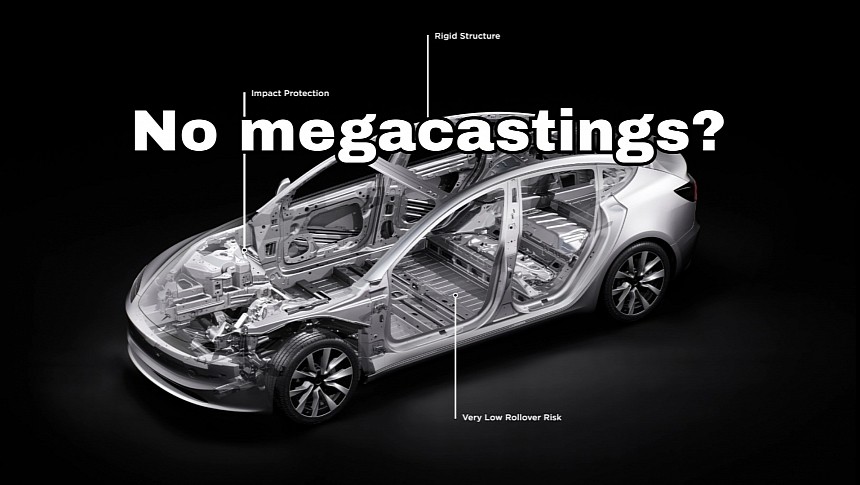Among the most significant changes expected with the refreshed Model 3 were switching to a structural battery pack and the use of megacastings, similar to how the Model Y is built. Still, a Highland body-in-white image posted on Tesla's European and Chinese websites shows no signs of these updated structures.
The primary purpose of the Tesla Model 3 refresh was to cut manufacturing costs. This is why the first rumors indicated that Tesla would scrap some features and parts. Adding new items to the Model 3 feature list was welcome, although nobody expected groundbreaking features that would increase the Model 3 cost. Tesla did remove the stalks and moved crucial controls on the steering wheel and the infotainment screen to cut costs.
When Tesla introduced the single-piece megacastings and a structural battery pack to the Model Y, it touted the cost benefits and manufacturing optimizations these could bring. It could be huge, freeing a lot of factory floor and assembly robots and reducing the time needed to build the car's body-in-white. Everybody thought the Model 3 Highland would also get this treatment. Still, it appears that Tesla did not pursue this strategy with the refreshed Model 3, at least the one built at Giga Shanghai.
The image of the Model 3 body-in-white featured on Tesla's website shows that the refreshed Model 3 has a similar structure to the pre-Highland model. There are no signs of front or rear megacastings and, indeed, no structural battery pack. Tesla considered that the best cost optimization would be not to change anything to the Model 3 structure. This could be one of the possible explanations.
Another explanation could be that producing the megacastings in China is not possible, or the technology might be under embargo. We know that Tesla patented an advanced alloy material for the megacastings. The front megacasting has a crucial role in crash protection, and its structure and material are highly sensitive. That explains why Tesla only built the Model Y at Giga Shanghai with rear megacastings. Meanwhile, the front frame is still using the conventional manufacturing technique.
To add to the confusion, Tesla is doing the same at its Fremont factory, with only the rear structure produced as a single-piece casting. So far, only Giga Berlin and Giga Texas are building the Model Y with front and rear megacastings. Whatever the reason, there's still a chance that the Model 3 Highland produced in Fremont will feature single-piece megacastings similar to the Model Y. It could start with the rear structure and later move to a dual-megacasting design.
The consequences of continuing to build the Model 3 with the old body-in-white structure are far-reaching. The first and most obvious is that the cost savings are limited. That would explain why Tesla set a higher price for the refreshed Model 3 in China, despite rumors that the new model will be more affordable.
Using megacastings would've also allowed Tesla to build the Model 3 on the same production line as the Model Y at Giga Texas and Giga Berlin. This is no longer possible, at least not until Tesla adopts the same structure for the refreshed Model 3. This could happen overnight at some point, as it happened with the Model Y. We still have to see what will happen with the Fremont-made Model 3.
When Tesla introduced the single-piece megacastings and a structural battery pack to the Model Y, it touted the cost benefits and manufacturing optimizations these could bring. It could be huge, freeing a lot of factory floor and assembly robots and reducing the time needed to build the car's body-in-white. Everybody thought the Model 3 Highland would also get this treatment. Still, it appears that Tesla did not pursue this strategy with the refreshed Model 3, at least the one built at Giga Shanghai.
The image of the Model 3 body-in-white featured on Tesla's website shows that the refreshed Model 3 has a similar structure to the pre-Highland model. There are no signs of front or rear megacastings and, indeed, no structural battery pack. Tesla considered that the best cost optimization would be not to change anything to the Model 3 structure. This could be one of the possible explanations.
Another explanation could be that producing the megacastings in China is not possible, or the technology might be under embargo. We know that Tesla patented an advanced alloy material for the megacastings. The front megacasting has a crucial role in crash protection, and its structure and material are highly sensitive. That explains why Tesla only built the Model Y at Giga Shanghai with rear megacastings. Meanwhile, the front frame is still using the conventional manufacturing technique.
To add to the confusion, Tesla is doing the same at its Fremont factory, with only the rear structure produced as a single-piece casting. So far, only Giga Berlin and Giga Texas are building the Model Y with front and rear megacastings. Whatever the reason, there's still a chance that the Model 3 Highland produced in Fremont will feature single-piece megacastings similar to the Model Y. It could start with the rear structure and later move to a dual-megacasting design.
The consequences of continuing to build the Model 3 with the old body-in-white structure are far-reaching. The first and most obvious is that the cost savings are limited. That would explain why Tesla set a higher price for the refreshed Model 3 in China, despite rumors that the new model will be more affordable.
Using megacastings would've also allowed Tesla to build the Model 3 on the same production line as the Model Y at Giga Texas and Giga Berlin. This is no longer possible, at least not until Tesla adopts the same structure for the refreshed Model 3. This could happen overnight at some point, as it happened with the Model Y. We still have to see what will happen with the Fremont-made Model 3.
















